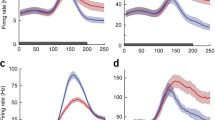Abstract
An unsupervised learning principle is proposed for individual neurons with complex synaptic structure and dynamical input. The learning goal is a neuronal response to temporal constancies: If some input patterns often occur in close temporal succession, then the neuron should respond either to all of them or to none. It is shown that linear threshold neurons can achieve this learning goal, if each synapse stores not only a weight, but also a short-term memory trace. The online learning process requires no biologically implausible interactions. The sequence of temporal associations can be interpreted as a random walk on the state transition graph of the input dynamics. In numerical simulations the learning process turned out to be robust against parameter changes.
Access this chapter
Tax calculation will be finalised at checkout
Purchases are for personal use only
Preview
Unable to display preview. Download preview PDF.
Similar content being viewed by others
References
Eisele, M., Vereinfachung generierender Partitionen von chaotischen Attraktoren, (German) PhD-thesis, Appendix D, ISSN 0944-2952 Jül-report 3021, KFA-Jülich, Jülich (1995).
Földiak, P., Learning invariance from transformation sequences, Neural Computation, Vol.3 (1991), pp194–200.
Mitchison, G. J., Removing time variation with the anti-hebbian differential synapse. Neural Computation, Vol.3 (1991), pp312–320.
Miyashita, Y. & Chang, H.-S., Neuronal correlate of pictorial short-term memory in the primate temporal cortex, Nature, Vol. 331 (1988), pp68–70.
Oram, M. W. &; Perret, D. I., Modeling visual recognition from neurobiological constraints, Neural Networks, Vol.7 (1994), pp945–972.
Wallis, G., Rolls, E. T., &; Foldiak, P., Learning invariant responses to the natural transformations of objects, Int. Joint Conf. on Neural Net., Vol.2 (1993), pp1087–1090.
Author information
Authors and Affiliations
Editor information
Editors and Affiliations
Rights and permissions
Copyright information
© 1997 Springer Science+Business Media New York
About this chapter
Cite this chapter
Eisele, M. (1997). Unsupervised Learning of Temporal Constancies by Pyramidal-Type Neurons.. In: Ellacott, S.W., Mason, J.C., Anderson, I.J. (eds) Mathematics of Neural Networks. Operations Research/Computer Science Interfaces Series, vol 8. Springer, Boston, MA. https://doi.org/10.1007/978-1-4615-6099-9_27
Download citation
DOI: https://doi.org/10.1007/978-1-4615-6099-9_27
Publisher Name: Springer, Boston, MA
Print ISBN: 978-1-4613-7794-8
Online ISBN: 978-1-4615-6099-9
eBook Packages: Springer Book Archive




